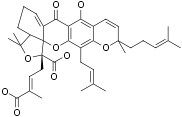Overview
- Fischer, W. et al. (2014) Purinergic Signal. 10, 313.
 Alomone Labs Garcinolic acid activates human P2X7 receptors expressed in HEK-293 cells.Dose response curve of hP2X7 activation by Garcinolic acid (#G-155). Cells were loaded with Fluo-8 NW dye, and stimulated with increasing concentrations of Garcinolic acid. Changes in intracellular Ca2+ following agonist application were detected as changes in maximum relative fluorescence (RLU) using FLIPRTETRA™.
Alomone Labs Garcinolic acid activates human P2X7 receptors expressed in HEK-293 cells.Dose response curve of hP2X7 activation by Garcinolic acid (#G-155). Cells were loaded with Fluo-8 NW dye, and stimulated with increasing concentrations of Garcinolic acid. Changes in intracellular Ca2+ following agonist application were detected as changes in maximum relative fluorescence (RLU) using FLIPRTETRA™.
- Fischer, W. et al. (2014) Purinergic Signal. 10, 313.
- Deng, Y.X. et al. (2012) Fitoterapia 83, 1548.
- Stokes, L. et al. (2006) Br. J. Pharmacol. 149, 880.
Garcinolic acid, a type of xanthone, is a positive modulator of the purinergic P2X7 receptors. It facilitates and potentiates cellular responses mediated by the purinergic P2X7 receptors at concentrations over 10 µM1,2.
P2X receptors are ligand-gated cation-permeable channel complexes that are activated by extracellular ATP. This family contains seven subtypes: P2X1-P2X7 that can be assembled as trimeric complexes. P2X7 receptors participate in a variety of cellular responses such as membrane permeabilization, activation of caspases, cytokine release, cell proliferation, and apoptosis. P2X7 receptors are expressed in almost all tissues, particularly in cells of haematopoietic origin1,3.
Garcinolic acid (#G-155) is a highly pure, natural, and biologically active compound.

